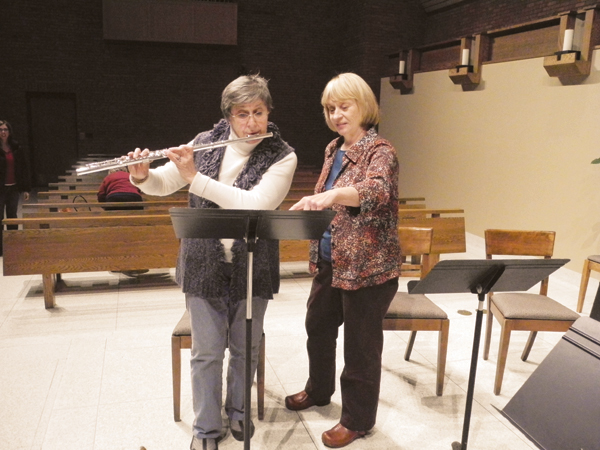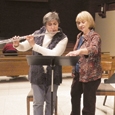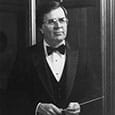
Every teacher’s lament is there is never enough time with students. Most of my private high school students receive 28 lessons during the school year plus another eight to ten during the summer months depending on whether they attend a summer music festival. Incoming university freshmen receive about 98 lessons before graduation four years later or about 14 lessons per semester.
If a high school student hopes to enter a university or conservatory music program, the goal for student and teacher is to get the student accepted into the best program possible for his level of advancement and talent. A university student wants to become proficient as a musician and be accepted into graduate school to continue studies and eventually acquire a position in the music world. When I realized how little instructional time I had with students, I decided to change the content of my lessons.
New Teachers
When I observe my college students teaching private lessons, I notice that they discuss with their students topics we have recently covered in their own lessons. While it is good that they are thinking about the lesson material, it is not appropriate for the level of the students they are teaching. I coined the phrase “The easiest lesson to give is the last lesson you took” to describe this event. When I say this, the novice teacher laughs and immediately sees the fallacy of his endeavors, and then asks, “but what should I be teaching?”
Curriculum Style
There are three common curriculum choices used by studio teachers today. First is the teacher who lets students choose their own instructional path. Students decide what to bring to lessons, and the teacher coaches them on it. For this to work well, the teacher has to be sure that the student brings in fresh repertoire on a regular basis. During my student days some of my conservatory colleagues studied voice with a professor who let them select their own repertoire. They spent hours in the library listening to recordings and studying scores before making repertoire choices. Several commented that they found this type of teaching frustrating because they knew they needed a balance of singing arias and art songs in English, French, German, and Italian, but as undergraduates were not familiar enough with the composers or the style periods to know where to look or which compositions were important. Personally, I think there is so much to learn as a musician that having a teacher to guide you through this ever-growing wealth of material and put it into prospective is one of the main benefits of applied study.
Some teachers tailor a curriculum specifically for each student while others have a core curriculum that every student progresses through. A good option, especially for new teachers is to develop a core curriculum and then offer options at every juncture to customize the repertoire to suit a particular flutist’s strengths and weaknesses. For example, in studying concerto repertoire of the Classical Era, a student and teacher may choose from works by Mozart, Devienne, Abel, CPE Bach, Benda, or Boccherini. Not every student should play the same concertos, but of course at sometime during the course of study they all should learn the standard works of the period such as the Mozart G Major, K. 313 and D Major, K. 314 flute concertos.
There is so much to learn and so little time to learn it. Students who study with a teacher who has no curriculum run the risk of not getting through enough material during their formal studies.
Curriculum Design
The most successful teachers can articulate where they want students to be by a certain date and design a curriculum to meet this goal. For teachers of high school students, this date could be at the end of the senior year or the date a flutist leaves for college. At the undergraduate level it might be graduation or a graduate school audition. For graduate school it could be an audition for an orchestral or teaching position. With a core curriculum teachers can plot out week by week how much material should be learned during the allotted time span.
Getting Started
Music schools and conservatories post audition requirements for incoming freshmen and graduate students online. These audition lists are useful starting places for preparing a curriculum. Download six to eight of these from the best music schools in the country. Look for common threads in the requirements and make them part of the core curriculum.
Most universities also require studio teachers to develop a course syllabus for each of the eight terms of instruction for a bachelor’s degree. The departments and schools of music post this syllabus online for incoming students to read. High school flute teachers should understand what the university expects students to accomplish at each level, freshman through senior year. This will help them design a curriculum so students will be prepared to meet the demands. Again, download six to eight of these course syllabi and examine the requirements.
Dividing the Hour
Most experienced teachers divide lesson time into three parts: flute fundaments (the warm-up, articulation, tone development, theoretical material), etudes, and solo work. Solo work includes sonatas, concertos, orchestral excerpts and chamber music. Besides dividing the hour by topics, a good teacher understands that planning the lesson by levels of difficulty will evoke a positive response from students. A lesson should begin with something the student feels comfortable with (similar warm-ups, tone exercises, scale/arpeggio exercises from lesson to lesson) and progress to the most intense and difficult concepts in the middle of the lesson, and conclude with something a student feels comfortable with and can play successfully. If there is time, many teachers finish a lesson by playing a duet with the student.
Expectations
Figuring out what students do not know is one of the greatest challenges for teachers. So many times a student has come in for an audition playing the Daphnis et Chloe excerpt pretty well, but then when sightreading something unfamiliar, it becomes obvious that there is little understanding of the elements of great playing, including rhythmic control, clear attacks and expressive tapers, control of shaping the individual notes, playing the contour of the phrase, dealing with non-chord tones, use of inflection and colors, style considerations, and vibrato control. When this happens, I know the student has been coached and coached on the Ravel excerpt, but has not been taught the rudiments of being a musician. My goal is to hone in on the most obvious problem, solve it and then move on to the next most obvious problem. I have had the best results in doing this when I show a student a curriculum plan so that he can see that this basic work will improve his total package for the future. In selecting music for a student, choose something that will be of some interest to him, or he will not practice it. We all practice what fascinates us.
Basic Concepts
In my curriculum, for the first two-thirds portion of a lesson, there will be one book for the theoretical portion (17 Big Daily Exercises by Taffanel & Gaubert or The Flute Scale Book by George & Louke) and one for technical development (Hugues, Altes, Andersen, Boehm, Kohler, Karg-Elert, Casterade). Some teachers also use a tone study book; but remember any exercise in any book, if played at a slow tempo, can become a tone study. The final third of a lesson will be spent on solos, concertos, excerpts, and chamber music and will vary from time to time.
There are many teachers who have a student spend two or three years polishing a concerto for a future competition. While learning to play with perfection, if perfection can really ever be achieved, is noble, I worry about the student who has experienced such a small portion of the repertoire. The philosophy of learning one sonata or one concerto per term means, that at the end of a Bachelor’s degree, a student knows only eight pieces. No flutist can build a career on a repertoire of eight pieces. Students who seem to progress better musically are ones who have been exposed to a vast array of literature so they learn to make comparisons from one piece to the next and can contrast one style period against another. Ideally, there should be some solo pieces that can be passed off rather quickly and others that are longer term projects. In the real music world, musicians who can learn quickly and accurately are rewarded with opportunities.
With so little time, it is essential that teachers have a plan to cover the necessary material. Whether you are a first year teacher or a seasoned one, constructing and continually updating an existing curriculum can be a fruitful process. I am always looking for a more efficient and effective way to teach musical and technical challenges. Students who observe their teachers asking questions, exploring pedagogical theories and ideas, using a wide range of repertoire options, and making a comprehensive plan tend to become outstanding musicians and teachers themselves.
A Sample Lesson Plan
1. Warmup – Each lesson begins with a warm-up. (Go to Patrica George Extras for free downloads of some of this material.) The warm-up includes making a ringing note (playing a D5 with the most beautiful tone), harmonic work (to recall where the flute overblows and for embouchure flexibility), octave variations (for fingering review), vibrato and articulation work.
2. Scales – Begin in the key of F major because the flute is well-balanced in the hands in this key. Learn all the major scales first. Use the Super Scale Routine from the Flute Talk website to drill the scales. If one key is learned a week, in twelve weeks all of the keys will be known. Once the major scales are learned, begin study of the major scales in thirds before moving on to the major two-octave arpeggios. Each week chunk the chromatic scale by four notes, followed by a rest from C4 to C7, ascending only. Notice that C, E, and Ab will begin a group of notes each time in each of the three octaves. As the year progresses, repeat the same organizational plan for the minor scales, scales in thirds and minor arpeggios. A metronome and a tuner are excellent tools for successful practice.
3. Etudes – My all-time favorite etude book is the 40 Studies, Op. 101 by Luigi Hugues (1836-1913), a professor of geography at the University of Turin and an excellent amateur musician. While he is primarily known as a writer of virtuosic flute and piano pieces in the theme and variation form, his etudes show a clear understanding of the flute and its technique. The Op. 101 is really a book of scales and sequential patterns in the most used keys and it can be practiced in so many ways. (Apply the principles of the Super Scale Routine.) Start with chunking by beamed groups of notes. Then chunk by measure, by two measures, by four measures or by slurs. Most students can do one or two of these etudes per week. To save time during the lesson, have students record the etudes at home and bring them in on a CD or memory stick, or send them as an attachment in an email. You can listen to the etude while a student is unpacking music and assembling the flute. If there is technical problem, fix it during the lesson; otherwise, this is time gained for other things in the lesson. Most students enjoy this recording project each week and certainly improve during the recording process. (One student remarked to me that she had not realized how many times she stopped and started while playing an etude.)
A perfect companion to the Hugues etudes is the Altes. While the Hugues is about playing scales and sequential patterns, the Altes is about playing intervals. These two technical elements certainly develop a clean technique in a student.
4. Solos – I divide solos into four units. As mentioned previously, most high school students receive approximately 40 lessons per year. If you divide the number of lessons by the four units, it allows about eight to ten weeks on each repertoire unit. Some students can progress faster than others. I would suggest including two compositions from each style period. The list on page 21 offers a sample curriculum with some suggested pieces. These pieces are all time-proven favorites of my students. Once again, if the student is fascinated with the repertoire, he will practice. Designing a curriculum that includes these elements of style and genre helps educate the student to what is available in the flute repertoire.
A Sample Curriculum for a 9th Grade Flutist
1. The Flute Scale Book by George & Louke
Chapter 3 – Embouchure development and flexibility
Chapter 4 – Audition Scales, Scales in thirds, Arpeggios
Chapter 6 – Chromatic Scales
40 Studies, Op. 101 by Luigi Hugues
2-4 per week. Chunked by beaming and then played as written
26 Selected Studies by Henri Altes
1-2 per week.
2. Solos: These repertoire suggestions include two compositions from each style period: Baroque (Telemann, Bach), Classical (Mozart, Boccherini), Romantic (Donizetti, Demersseman), and Modern (Faure, Ferroud). There are also two unaccompanied pieces (Telemann, Ferroud), three flute and piano pieces (Bach, Demersseman, Faure), and three concertos (Boccherini, Mozart, Donizetti).
Unit One:
Fantasia No. 4 in Bb Major by Georg Philip Telemann
Sonata (also called Concertino with a few changes) by Gaetano Donizetti
Unit Two:
Sonata in C Major by J.S. Bach
Andante in C, K. 315 by W. A. Mozart
Unit Three:
Trois Pieces for Flute, 2nd piece, “Jade” by P. O. Ferroud
Fantasie, Op. 79 by Gabriel Faure
Unit Four:
Concerto in D Major, 1st movement by Luigi Boccherini
Solo de Concert, No. 6, F Major by Jules Auguste Demersseman






